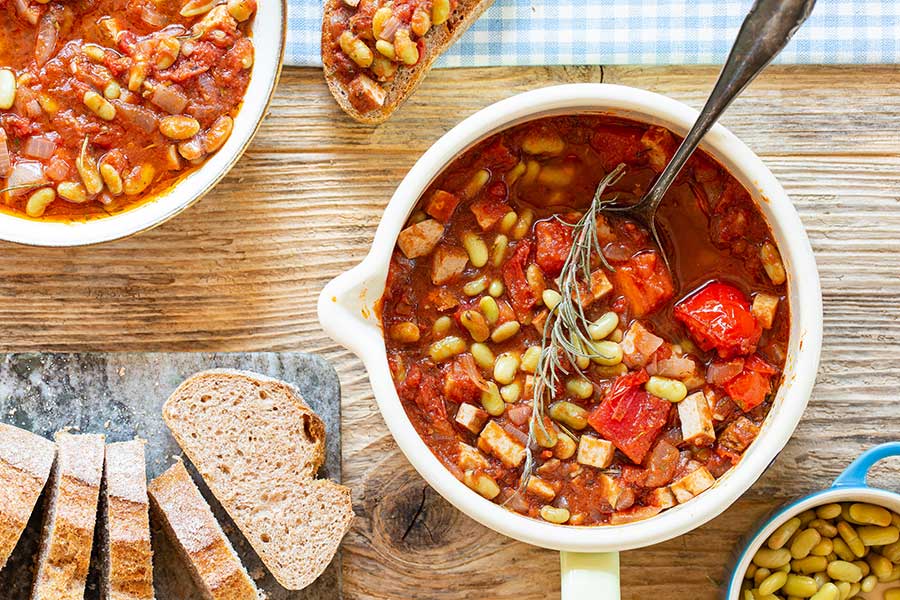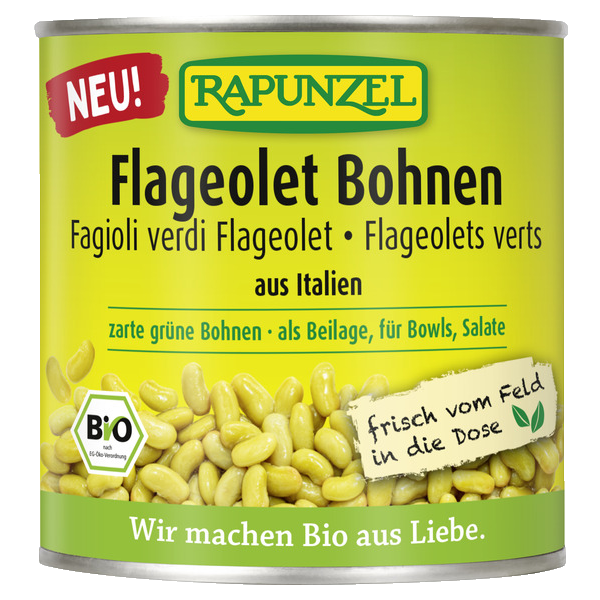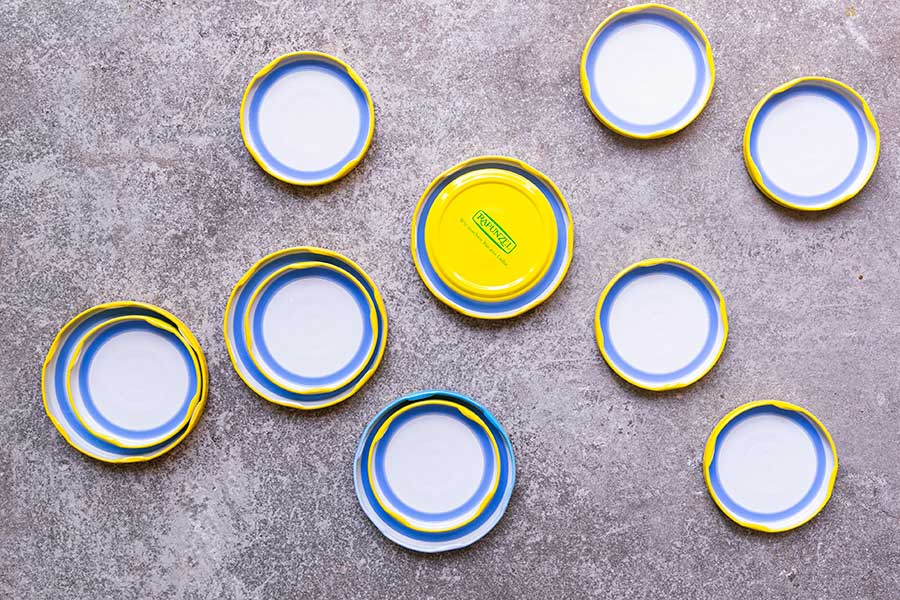Flageolet beans ready to use - for the quick and easy organic kitchen! The delicate, mild bean with its slightly nutty taste is particularly popular in French cuisine and a real classic there. Bean connoisseurs appreciate its mild flavor and versatile uses. Because of their small size, flageolets are also a great addition to many dishes. The pale green Flageolets beans of Rapunzel are grown in Italy and processed directly after the harvest. It takes no longer than 6 hours to get from the field into the can. Harvest-fresh quality you can taste.
Ingredients
flageolet* beans, water, sea salt
* = ingredients from organic farming
** = from biodynamic agriculture
flageolet* beans, water, sea salt
* = ingredients from organic farming
** = from biodynamic agriculture
Characteristics
delicate, mild beans, cultivated in Europe
Usage
ideal for salads, bowls, Mediterranean dishes, as a filling for wraps and tacos or as a fine side dish. Can also be used instead of Edamamé soy beans.
delicate, mild beans, cultivated in Europe
Usage
ideal for salads, bowls, Mediterranean dishes, as a filling for wraps and tacos or as a fine side dish. Can also be used instead of Edamamé soy beans.
Additional information
Preparation
The cooked Flageolet beans are canned with a little sea salt and water and heated for preservation.
Produced in
Italy
Country of origin
italian agriculture
Origin of the main ingredients
Italy
Quality
EU Bio-Logo
Storage advice
After opening, store in a cool place and use quickly.
Legal name of the food product
Flageolet beans canned
| Calorific value | 405 kJ / 96 kcal | |
| Fat | 0,70 g | |
| of which saturates | 0,10 g | |
| Carbohydrates | 13,00 g | |
| Sugar | 0,20 g | |
| Dietary fiber | 5,7 g | |
| Protein | 6,30 g | |
| Salt | 0,700 g |
Allergens
| Eggs and products thereof | not contained | |
| Peanuts and products thereof | not contained | |
| Fish and products thereof | not contained | |
| Cereals containing gluten or cereal products | not contained | |
| Crustaceans and products thereof | not contained | |
| Milk and products thereof including lactose | not contained | |
| Lupins and products thereof | not contained | |
| Nuts and products thereof | not contained | |
| Celery and products thereof | not contained | |
| Mustard and products thereof | not contained | |
| Sesame seeds and products thereof | not contained | |
| Soy and products thereof | not contained | |
| Sulfur dioxide or sulfites (more than 10mg/kg or 10 mg/l SO2) |
no | |
| Molluscs and products thereof | not contained |
Mit großer Sorgfalt pflegen wir unsere Online-Produktdatenbank. Dennoch können wir vereinzelte Fehler nicht ausschließen. Daher bitten wir Sie, diese Angaben immer mit dem Etikett des jeweiligen Produktes zu vergleichen. Sollten Ihnen Unstimmigkeiten auffallen, sind wir dankbar für einen Hinweis an kundenservice@rapunzel.de.
FAQ about Flageolet beans canned
In the case of organic cereal products, despite intensive labour input during cultivation and intensive cleaning measures, the presence of foreign seeds cannot be completely ruled out, nor can products with optical deviations.
The colour of a grain or seed in cereals, legumes and oilseeds varies from harvest to harvest due to many factors such as soil conditions, climate and weather. Since we work with many small farmers from different growing areas, the products are exposed to different influences that lead to natural colour variations. Extreme weather conditions can cause such severe optical changes that it is no longer possible to sort out grains and seeds at a reasonable economic cost. However, as we value long-term economic cooperation with the small farmers, we also buy the harvest in difficult years and try to use it in the best possible way.
No herbicides are used in the organic sector. Thus, in some cases, even weed seeds of the same weight or size are very difficult to remove from the product.
Of course, these products are subject to particularly intensive controls by us and are only traded if it is a purely visual problem, without any effects in terms of taste and nutritional quality.
We are trying to further improve our possibilities for mechanical cleaning, but this is sometimes very difficult due to physical limits (e.g., 0.5 mm amaranth).
mehr erfahren
mehr erfahren
mehr erfahren
mehr erfahren
This is easier than you think, because most of it happens quite incidentally:
1. Soak: Soak the legumes (8 to 12 hrs, i.e., overnight or in the morning if you want to cook them in the evening).
Tip: Lentils are only rinsed and can be cooked without soaking.
2. Rinse:
Drain the soaking water and rinse the legumes well in a sieve.
3. Cook:
Place in a pot with fresh water and cook according to the package instructions with the lid closed.
4. Drain
– and ready!
mehr erfahren
mehr erfahren
In 3 times the quantity of cold water, in a large container, as the legumes increase in volume. Covered, at room temperature. The water is not changed, nor is stirring necessary. Afterwards, pour away the soaking water and rinse the legumes, this improves tolerability. And soaking reduces cooking time, which saves time and energy. The nutrient content of the soaking water is rather low.
mehr erfahren
mehr erfahren
In a large saucepan, with 3 times the amount of water, bring to a boil, then simmer gently (not bubbling) with the lid on. The cooking time is reduced in a pressure cooker.
Salting is done after cooking, that is what our experience has shown. Acid in vinegar, lemon, tomatoes, etc., hardens the cell structure, so likewise only add after cooking. Baking soda shortens the cooking time, use sparingly otherwise it can taste slightly soapy.
Even with long cooking times, legumes lose relatively few nutrients.
mehr erfahren
mehr erfahren
We recommend pouring away the soaking water and not using it for cooking. The soaking water may contain dust particles and saponins that promote foaming during cooking. If you remove the soaking water, the legumes are usually more digestible, as substances that are difficult to digest dissolve in the soaking water. The nutrient content of the soaking water is rather low. Legumes lose relatively few nutrients even with long cooking times
mehr erfahren
mehr erfahren
Proper preparation & acclimation are everything: Wash, soak (this dissolves hard-to-digest carbohydrates), pour away the soaking water and cook. This helps. And as a newbie, start slowly and eat legumes regularly. Peeled varieties such as red/yellow lentils or mung beans and smaller legumes are more digestible. Herbs such as cumin, bay leaf, ginger, bean greens, fennel, cumin, thyme, etc., also help digestion and add flavour.
mehr erfahren
mehr erfahren
It is best to prepare a larger quantity for several days and store it in the fridge. Freezing is also possible: Either immediately after soaking and rinsing – frozen then just add to the cooking water and cook. Or freeze after cooking. Drain and leave to cool. For freezing, it is best to pat the legumes dry (so they do not stick together and can be taken out in any quantity).
Tip: Glass jars are also suitable for freezing. And preserving is also possible.
mehr erfahren
mehr erfahren
Legumes should not be eaten raw and should be soaked before cooking (except lentils, where soaking is not necessary). There is a reason for this, because like many other foods, legumes also naturally contain plant substances in their raw state that are not ideal for the human body. But here it depends on the preparation: Soaking legumes, throwing away the soaking water, rinsing and cooking breaks down these substances and deactivates them. This is because some of them are water-soluble and some are heat-sensitive.
mehr erfahren
mehr erfahren
Recipe with Flageolet beans canned


Flageolet beans à la provençale


